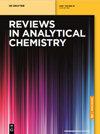Analysis of initiator content of prepreg by near-infrared spectroscopy
IF 3.8
3区 化学
Q2 CHEMISTRY, ANALYTICAL
引用次数: 0
Abstract
Abstract During the production process of some copper clad laminate (CCL), the content of 3,3,5,7,7-pentamethyl-1,2,4-trioxepane in prepreg can affect the cross-linking and curing degree of resin directly, and thereby affect the properties of CCL. In this article, near-infrared (NIR) spectroscopy combined with partial least square regression using high performance liquid chromatography as a reference method were used for the determination of 3,3,5,7,7-pentamethyl-1,2,4-trioxepane in the CCL production progress. 160 spectra of prepreg samples randomly formed the calibration set, and 50 spectra of prepreg samples formed the validation set. The value of the root mean square error of calibration (w/w) and root mean square error of prediction (w/w) were 0.011% and 0.013% for 3,3,5,7,7-pentamethyl-1,2,4-trioxepane content (%, w/w), and the calculation and validation of the regression equation resulted in high correlation coefficients of 0.99 and 0.98, respectively. The scatter plot value of calibration set which was obtained from the root mean square error of cross-validation (w/w) was 0.015%, and the regression equation resulted in high correlation coefficient of 0.98. The results of the paired t-test revealed that there was no significant difference between NIR and HPLC method. Thus, the results obtained in this study reflect that NIR could be used as a rapid, accurate, and simultaneous technique to determine 3,3,5,7,7-pentamethyl-1,2,4-trioxepane content of prepreg in the production process.近红外光谱分析预浸料引发剂含量
摘要在某些覆铜层压板(CCL)的生产过程中,预浸料中3,3,5,7,7-五甲基-1,2,4-三氧基烷的含量直接影响树脂的交联和固化程度,从而影响覆铜层压板的性能。本文以高效液相色谱法为参比方法,采用近红外光谱法结合偏最小二乘回归法测定了CCL生产过程中3,3,5,7,7-五甲基-1,2,4-三氧杂烷的含量。160个预浸料样品的光谱随机组成校准集,50个预浸料样品的光谱随机组成验证集。3、3、5、7、7-五甲基-1,2,4-三氧杂烷含量(%,w/w)的校正均方根误差(w/w)和预测均方根误差(w/w)分别为0.011%和0.013%,回归方程的计算和验证的相关系数分别为0.99和0.98。交叉验证均方根误差(w/w)得到的校正集散点图值为0.015%,回归方程的相关系数为0.98。配对t检验结果显示,近红外光谱法与高效液相色谱法无显著差异。因此,本研究结果表明,近红外光谱可以作为一种快速、准确、同时测定生产过程中预浸料中3,3,5,7,7-五甲基-1,2,4-三氧杂烷含量的技术。
本文章由计算机程序翻译,如有差异,请以英文原文为准。
求助全文
约1分钟内获得全文
求助全文
来源期刊

Reviews in Analytical Chemistry
化学-分析化学
CiteScore
7.50
自引率
0.00%
发文量
15
审稿时长
>12 weeks
期刊介绍:
Reviews in Analytical Chemistry publishes authoritative reviews by leading experts in the dynamic field of chemical analysis. The subjects can encompass all branches of modern analytical chemistry such as spectroscopy, chromatography, mass spectrometry, electrochemistry and trace analysis and their applications to areas such as environmental control, pharmaceutical industry, automation and other relevant areas. Review articles bring the expert up to date in a concise manner and provide researchers an overview of new techniques and methods.
 求助内容:
求助内容: 应助结果提醒方式:
应助结果提醒方式:


